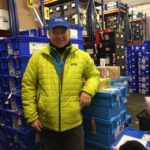Updated on March 29, 2018
A Visit to the Global Seed Vault: Part II
Once we reach the entrance to the Vault, we are met by the representative from NordGen, the gene bank of the five Nordic countries who operate the Vault and approved our visit. Once the outer door closes, we are briefed in the vestibule. Then, we enter through a second door leading to the 100-meter-long tunnel descending into the mountain. Through the tunnel, a third door brings us into the anteroom in front of the three 30′ by 90′ chambers carved out of rock. Only the middle room is now in use, but its shelves are 85% full of deposits, so soon another room will be active. In this room, we can see the actual frost and ice covered door leading into the Vault. Once this door is secured behind us, the final door is opened and we enter the actual vault. It is here that the nearly one million deposits are stored, boxed as originally received and prepared to NordGen’s exacting standards. Each box is labeled with the name of the owner, barcodes and other identifying information to keep track of the deposits.

It is only now as we stand in this small frigid space no larger than a classroom, does the magnitude of what it holds strike you. Collected in this room are seeds gathered from around the world – and over the time of our existence – representing the food crops upon which our lives are formed. It is not the gold bullion of Ft. Knox or the priceless art works secreted away in a Swiss bank – instead, it is the simple seeds we plant. They reflect the cumulative results of nature, evolution, and humans’ efforts to identify and improve our food crops.
Being in the presence of the seeds makes one think about not just the human history they contain, but the fragile nature of our very existence. Walking the aisles you read the labels of the seed banks from every corner of the world. We can’t see inside the boxes – even NordGen officials cannot open them. But we know they are filled with envelopes, each holding 250-500 seeds of a distinct crop variety selected by a seed bank for safe keeping. Over 150,000 varieties of rice and 160,000 of wheat join the thousands more representing over 150 food crops important to people somewhere.
Being inside the Vault makes real the stories I have read. It also brings a new appreciation and understanding of the work of many people – the plant collectors, the seed breeders, the farmers, and the gene bank officials who have collected, improved, and saved these seeds. One does not need to be a person of faith to feel a visit to the Vault is moving in a spiritual way.
Next week, the story of our visit will conclude with thoughts on what the Seed Vault may mean for the future of agriculture and humanity.




